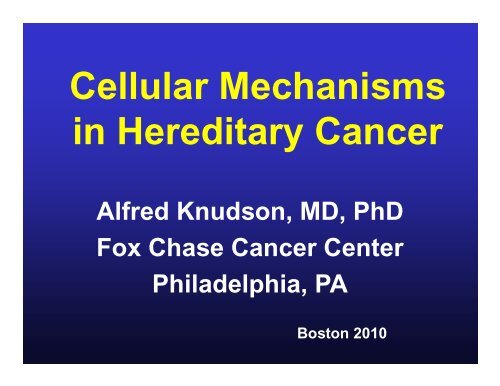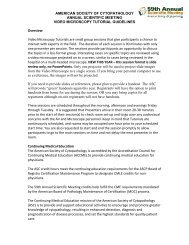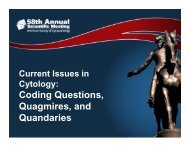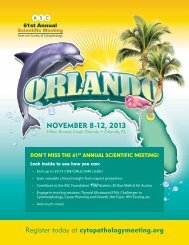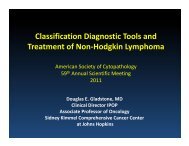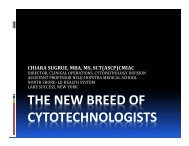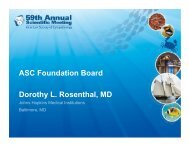Leopold Koss Lectureship Cellular Mechanisms in Hereditary Cancer
Leopold Koss Lectureship Cellular Mechanisms in Hereditary Cancer
Leopold Koss Lectureship Cellular Mechanisms in Hereditary Cancer
You also want an ePaper? Increase the reach of your titles
YUMPU automatically turns print PDFs into web optimized ePapers that Google loves.
<strong>Cellular</strong> <strong>Mechanisms</strong><strong>in</strong> <strong>Hereditary</strong> <strong>Cancer</strong>Alfred Knudson, MD, PhDFox Chase <strong>Cancer</strong> CenterPhiladelphia, PABoston 2010
OncodemesCategories of <strong>Cancer</strong> CausationEnvironment–+Heredity–+BackgroundHeredityEnvironmentInteraction
A Dom<strong>in</strong>antly Inherited <strong>Cancer</strong>
Mutational EquilibriumDom<strong>in</strong>antly Inherited Conditionp 2 + 2pq + q 2 = 1normal Heterozygote MutantHomozygoteNew mutations = 2 p 2Mutations lost by selection = 2pq • sAt Equilibrium2 p 2 = 2pq • sp=sqFor example: = 10 -5 , s = 0.5, 2pq = 4x10 -5
Ret<strong>in</strong>oblastoma
Ret<strong>in</strong>oblastoma: The Riska Dom<strong>in</strong>ant Gene ImpartsTumor ProbabilityNormal childGene carrierRelative riskAbout 3 per 100,0003 tumors per child3________=10 53X 10 -5
Two Hits <strong>in</strong> Ret<strong>in</strong>oblastoma
Ret<strong>in</strong>oblastomaTwo Mutations<strong>Hereditary</strong>Non-hereditary
Germl<strong>in</strong>e Deletion <strong>in</strong> RB Patient
Loss of HeterozygosityDur<strong>in</strong>g Carc<strong>in</strong>ogenesis
G1pRb PathwaypRbppRbSCdk4/D1p16Cdk4 + cycl<strong>in</strong> D1
RB1 is the first clonedhereditary cancer gene andfirst tumor suppressor gene
<strong>Hereditary</strong> <strong>Cancer</strong>Multiple Tumors<strong>Hereditary</strong>Ret<strong>in</strong>oblastomaRet<strong>in</strong>oblastomaSarcomasLung <strong>Cancer</strong>Li-FraumeniSyndromeBreast <strong>Cancer</strong>SarcomasLung <strong>Cancer</strong>
TP53 AlarmsONCOGENE(e.g., MYC)DNADAMAGEp14 ARFInactiveATM, CHK2mdm2p53ApoptosisCell Cycle Arrest
<strong>Cancer</strong>Increased cell birth rate-RB-1Decreased cell death rate-TP53
TP 53 and <strong>Cancer</strong>ApoptosisDNA RepairOxidative PhosphorylationInhibition of Angiogenesis
Smart DNA VirusesDNAVirusAdSV40HPVViralProte<strong>in</strong>E1AE1BTE6E7InactivatepRb p53+ –– ++ +– ++ –
Phakomatosesand their cloned genesNeurofibromatosesTuberous SclerosisVon-Hippel-L<strong>in</strong>dau S.Gorl<strong>in</strong>’s S.Cowden’s Dis.Peutz Jeghers Dis.Juvenile PolyposisAdenomatous PolyposisNF1, NF2TSC1, TSC2VHLPTCHPTENLKB1/STK11SMAD4/DPC4APC
Neurofibromatosis Type 1
Familial Polyposis Coli
Multiple Gene Mutations <strong>in</strong>Colorectal <strong>Cancer</strong>Normal Early adenoma Intermediate Late adenoma <strong>Cancer</strong>APC K-RAS SMAD2, 4 TP53Adapted from Ilyas et al. Eur. J. <strong>Cancer</strong> 1999; 35:335-351 and Kelloff et al. Oncology 1996; 10:1471-1484
Two-Hit LesionsAnd Renewal Tissue Growth
Phakomatoses Network
<strong>Hereditary</strong> Predispositionto Genomic InstabilityBRCA 1 and 2Bloom Syndrome(Recessive)
Human Chromosomes
Genomic Instability <strong>in</strong>Ovarian <strong>Cancer</strong>
Breakage-Fusion-Bridge Cycle
Double Strand Breaks(DSBs) <strong>in</strong> DNAOccur spontaneously (approx. 50) per cell cycleAlso <strong>in</strong>ducible by IR, ROS, and some chemicalsIf not repaired cell diesRepair can lead to:Recomb<strong>in</strong>ation (with LOH)Deletion (with LOH)TranslocationGenomic <strong>in</strong>stability (via BFB cycle)
DSBs and Mutationsby Radiation1 Gy 30 DSBsDoubl<strong>in</strong>g dose for mutationsApproximately 1.7 Gyabout 50 DSBs
DNA Double-Strand BreaksRepair by a Multi-prote<strong>in</strong> ComplexMsh2AtmBrca1/2Mlh1BlmFanc-D2Courtesy: Dr. Hong Yan
BLOOM SYNDROMETw<strong>in</strong> SpotsCourtesy: Dr. Anna Meadows
Bloom SyndromeSister Chromatid ExchangesNormal Bloom S.
Bloom SyndromeHomologous Recomb<strong>in</strong>ationCourtesy: Dr. James German
Mutational ConsequencesIn the Carc<strong>in</strong>omas• Growth of renewal tissue• Failure of differentiation/apoptosis• Genomic <strong>in</strong>stability


